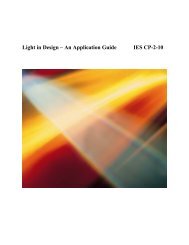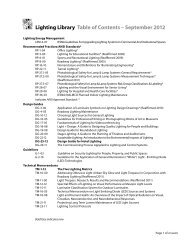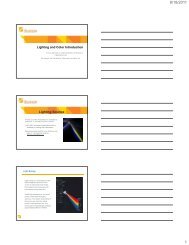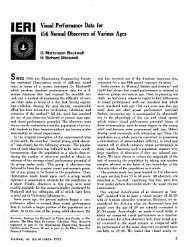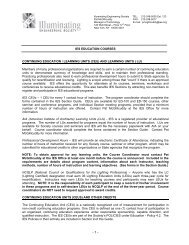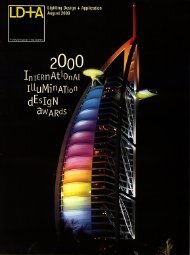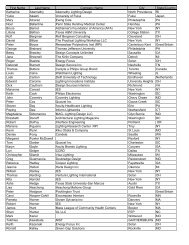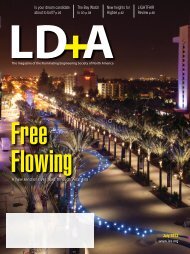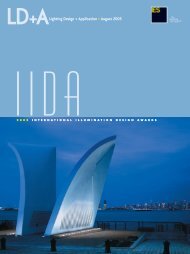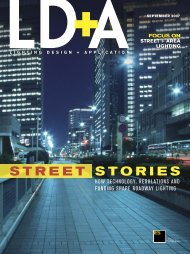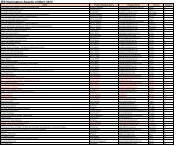faces of the future - Illuminating Engineering Society
faces of the future - Illuminating Engineering Society
faces of the future - Illuminating Engineering Society
Create successful ePaper yourself
Turn your PDF publications into a flip-book with our unique Google optimized e-Paper software.
LED WATCH<br />
The Standards Wave<br />
BY JAMES BRODRICK<br />
Rolls On<br />
At <strong>the</strong> movies, we get so caught<br />
up in <strong>the</strong> on-screen action that we<br />
seldom think about all <strong>the</strong> months <strong>of</strong><br />
behind-<strong>the</strong>-scenes work that made<br />
our two hours <strong>of</strong> cinematic enjoyment<br />
possible—much less about <strong>the</strong><br />
army <strong>of</strong> people who patiently and<br />
painstakingly carried out that work.<br />
Not just <strong>the</strong> producer, director and<br />
screenwriter, but also those unsung<br />
heroes—from <strong>the</strong> art director, to<br />
<strong>the</strong> set designer to <strong>the</strong> gaffer—who<br />
played far less glamorous roles.<br />
So it is with a technology like solid-state<br />
lighting (SSL). Most people<br />
focus only on <strong>the</strong> “wow factor” <strong>of</strong> <strong>the</strong><br />
end product, without considering all<br />
<strong>the</strong> little things that lie behind it. One<br />
<strong>of</strong> <strong>the</strong> most important <strong>of</strong> those “little<br />
things” is standards, which play a<br />
huge role in <strong>the</strong> development <strong>of</strong> any<br />
technology. Without standards and<br />
test methods to consistently characterize<br />
product performance and<br />
assure safety, an “anything-goes”<br />
mentality could create widespread<br />
confusion and make things difficult<br />
for manufacturers, consumers and<br />
specifiers alike.<br />
And that’s just what happened<br />
in <strong>the</strong> early years <strong>of</strong> SSL, which<br />
were likened more than once to <strong>the</strong><br />
Wild West. But recent progress in<br />
standards development has brought<br />
a semblance <strong>of</strong> law and order to<br />
Dodge City, thanks to <strong>the</strong> coordinated<br />
efforts <strong>of</strong> such organizations as<br />
<strong>the</strong> IES, NEMA, American National<br />
Standards Lighting Group (ANSLG),<br />
American National Standards<br />
Institute, National Institute <strong>of</strong><br />
Standards and Technology (NIST),<br />
Underwriters Laboratories, International<br />
Electrotechnical Commission,<br />
International Commission on<br />
Illumination (CIE) and Canadian<br />
Standards Association.<br />
These groups have helped develop<br />
standards that have already<br />
addressed many key aspects <strong>of</strong><br />
SSL—from nomenclature, to chromaticity<br />
and performance specifications,<br />
to power supply and safety.<br />
Two <strong>of</strong> <strong>the</strong> most important <strong>of</strong> <strong>the</strong>se<br />
standards have come from IES: LM-79<br />
specifies a standard test method for<br />
measuring <strong>the</strong> photometric and electrical<br />
properties <strong>of</strong> SSL devices in<br />
order to compare light output and calculate<br />
luminaire efficacy, while LM-80<br />
lays out procedures for measuring<br />
lumen degradation over time, a key<br />
component <strong>of</strong> reliability and lifetime.<br />
Both are up for <strong>the</strong>ir regularly scheduled<br />
two-year reviews, with committees<br />
already formed and well-armed<br />
with lists <strong>of</strong> newly surfaced issues<br />
that may need to be addressed by<br />
updates that enable <strong>the</strong> standards<br />
to keep pace with a rapidly evolving<br />
technology.<br />
TWO ON THE WAY<br />
Two related standards from<br />
NEMA, which have been in development,<br />
are nearing publication. SSL-1,<br />
“Electronic Drivers for LED Devices,<br />
Arrays, or Systems,” is in <strong>the</strong> balloting<br />
stage and is expected to be published<br />
by <strong>the</strong> end <strong>of</strong> <strong>the</strong> year. A logical<br />
sequel to LM-79, which looks at lamp<br />
performance, SSL-1 focuses on <strong>the</strong><br />
driver, which many feel is <strong>the</strong> weakest<br />
link in <strong>the</strong> SSL luminaire chain.<br />
The idea is to create some standards<br />
around drivers so that <strong>the</strong>y live up to<br />
<strong>the</strong> same lifetime claims as <strong>the</strong> LEDs.<br />
What good are LEDs that last for<br />
50,000-plus hours, if <strong>the</strong>y depend on<br />
a driver that lasts only 30,000 hours<br />
About as good as <strong>the</strong> proverbial cow<br />
that yields <strong>the</strong> sweetest milk in town<br />
but has an unfortunate habit <strong>of</strong> kicking<br />
<strong>the</strong> pail over.<br />
SSL-6, “Solid State Lighting<br />
for Incandescent Replacement-<br />
Dimming,” looks at ano<strong>the</strong>r issue<br />
that’s been getting quite a bit <strong>of</strong><br />
attention lately, namely, controllability.<br />
Many people assume that all<br />
LEDs are easily dimmable, but in<br />
fact that only holds true if <strong>the</strong> LED<br />
has an electronic driver with dimming<br />
capability and <strong>the</strong> driver is<br />
compatible with <strong>the</strong> chosen dimming<br />
control. SSL-6 provides interface<br />
recommendations for dimming<br />
control <strong>of</strong> integrated LED lamps<br />
intended to replace general service<br />
incandescent products. Like SSL-1,<br />
SSL-6 is in <strong>the</strong> balloting stage and<br />
should be published by year’s end,<br />
after which NEMA plans to initiate<br />
additional dimming standards. Both<br />
standards—SSL-1 and SSL-6—have<br />
been long-awaited and are sure to<br />
make a big difference when <strong>the</strong>y’re<br />
published, because <strong>the</strong>y’ll be filling<br />
what amounts to a huge void.<br />
THE QUESTION OF LIFETIME<br />
Still ano<strong>the</strong>r much-anticipated<br />
solid-state lighting document, which<br />
22 www.ies.org



